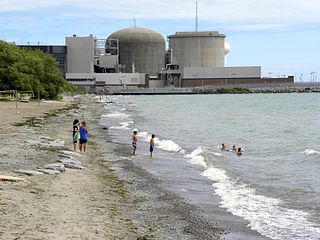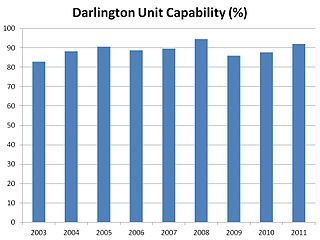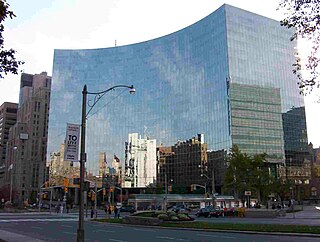
The CANDU is a Canadian pressurized heavy-water reactor design used to generate electric power. The acronym refers to its deuterium oxide moderator and its use of uranium fuel. CANDU reactors were first developed in the late 1950s and 1960s by a partnership between Atomic Energy of Canada Limited (AECL), the Hydro-Electric Power Commission of Ontario, Canadian General Electric, and other companies.

Pickering Nuclear Generating Station is a Canadian nuclear power station located on the north shore of Lake Ontario in Pickering, Ontario. It is one of the oldest nuclear power stations in the world and Canada's third-largest, with eight CANDU reactors. Since 2003, two of these units have been defueled and deactivated. The remaining six produce about 16% of Ontario's power and employ 3,000 workers.
Atomic Energy of Canada Limited (AECL) is a Canadian federal Crown corporation and Canada's largest nuclear science and technology laboratory. AECL developed the CANDU reactor technology starting in the 1950s, and in October 2011 licensed this technology to Candu Energy.

Bruce Nuclear Generating Station is a nuclear power station located on the eastern shore of Lake Huron in Ontario, Canada. It occupies 932 ha of land. The facility derives its name from Bruce Township, the local municipality when the plant was constructed, now Kincardine due to amalgamation. With eight CANDU pressurized heavy-water reactors, it was the world's largest fully operational nuclear generating station by total reactor count and the number of currently operational reactors until 2016, when it was exceeded in nameplate capacity by South Korea's Kori Nuclear Power Plant. The station is the largest employer in Bruce County, with over 4000 workers.

Darlington Nuclear Generating Station is a Canadian nuclear power station located on the north shore of Lake Ontario in Clarington, Ontario. It is a large nuclear facility comprising four CANDU nuclear reactors with a total output of 3,512 MWe when all units are online, providing about 20 percent of Ontario's electricity needs, enough to serve a city of two million people. The reactor design is significantly more powerful than those used in previous CANDU sites at Pickering and Bruce, making its 4-unit plant the second-largest in Canada behind the 8-unit Bruce. It is named for the Township of Darlington, the name of the municipality in which it is located, which is now part of the amalgamated Municipality of Clarington.

Point Lepreau Nuclear Generating Station is a nuclear power station located 2 km northeast of Point Lepreau, New Brunswick, Canada. The facility was constructed between 1975 and 1983 by NB Power, the provincially owned public utility.
Dwight Duncan is a former politician in Ontario, Canada. He was a Liberal member of the Legislative Assembly of Ontario from 1995 to 2013 who represented ridings of Windsor—Walkerville, Windsor—St. Clair and Windsor—Tecumseh. He was a senior member in the government of Dalton McGuinty who served in several cabinet roles including Deputy Premier and Minister of Finance.

Huron Wind is the first commercial wind farm in Ontario. It is located in the village of Inverhuron, Ontario near Tiverton, and consists of 5 Vestas V80-1.8MW wind turbines. It is next to the Bruce Power Visitor Centre, within sight of the Bruce Nuclear Generating Station, and adjacent to the larger Enbridge Ontario Wind Farm. Groundbreaking was on July 11, 2002, and it was declared officially in service on December 1, 2002.

Cameco Corporation is the world's largest publicly traded uranium company, based in Saskatoon, Saskatchewan, Canada. In 2015, it was the world's second largest uranium producer, accounting for 18% of world production.

The electricity sector in Canada has played a significant role in the economic and political life of the country since the late 19th century. The sector is organized along provincial and territorial lines. In a majority of provinces, large government-owned integrated public utilities play a leading role in the generation, transmission, and distribution of electricity. Ontario and Alberta have created electricity markets in the last decade to increase investment and competition in this sector of the economy.

Port Elgin is a community in Bruce County, Ontario, Canada. Its location is in the traditional territory of the Saugeen Ojibway Nation. Originally named Normanton the town was renamed Port Elgin when it was incorporated in 1874, after James Bruce, 8th Earl of Elgin, a former Governor General of the Province of Canada.
Nuclear Power Demonstration was the first Canadian nuclear power reactor, and the prototype for the CANDU reactor design. Built by Canadian General Electric, in partnership with Atomic Energy of Canada Limited (AECL) and the Hydro Electric Power Commission of Ontario it consisted of a single 22 MWe pressurized heavy water reactor (PHWR) unit located in Rolphton, Ontario, not far from AECL's Chalk River Laboratories. NPD was owned by AECL and operated by Ontario Hydro.

The Douglas Point Nuclear Generating Station was Canada’s first full-scale nuclear power plant and the second CANDU pressurised heavy water reactor. Its success was a major milestone and marked Canada's entry into the global nuclear power scene. The same site was later used for the Bruce Nuclear Generating Station.
Nuclear power in Canada is provided by 19 commercial reactors with a net capacity of 13.5 gigawatt (GW), producing a total of 95.6 terawatt-hours (TWh) of electricity, which accounted for 16.6% of the country's total electric energy generation in 2015. All but one of these reactors are located in Ontario, where they produced 61% of the province's electricity in 2019. Seven smaller reactors are used for research and to produce radiopharmaceuticals for use in nuclear medicine.

The Nanticoke Generating Station was a coal-fired power station in Nanticoke, Ontario in operation from 1972 to 2013. It was the largest coal power station in North America and, at full capacity, it could provide 3,964 MW of power into the southern Ontario power grid from its base in Nanticoke, Ontario, Canada, and provided as much as 15% of Ontario's electricity.

Energy Alberta Corporation was created in 2005 with a concept to provide nuclear power to the energy-intensive development of the oil sands resources in northern Alberta, Canada. The company was founded by Hank Swartout, CEO of Precision Drilling Corporation, and Wayne Henuset, co-owner of Willow Park Wines and Spirits in Calgary, Alberta. The company intended to build a nuclear plant on the shore of Lac Cardinal, 30 kilometres (19 mi) from Peace River, Alberta.

Ontario Power Generation Inc. (OPG) is a Crown corporation and "government business enterprise" that is responsible for approximately half of the electricity generation in the province of Ontario, Canada. It is wholly owned by the government of Ontario. Sources of electricity include nuclear, hydroelectric, wind, gas and biomass. Although Ontario has an open electricity market, the provincial government, as OPG's sole shareholder, regulates the price the company receives for its electricity to be less than the market average, in an attempt to stabilize prices. Since 1 April 2008, the company's rates have been regulated by the Ontario Energy Board.
Duncan Hawthorne is an international businessman in the electricity industry. He is the Chief Executive Officer of Horizon Nuclear Power. He holds an honours degree in control engineering from the Open University and an MBA from Strathclyde University in Glasgow.

Nuclear industry in Canada is an active business and research sector, producing about 15% of its electricity in nuclear power plants of domestic design. Canada is the world's largest exporter of uranium, and has the world's second largest proven reserves. Canada also exports nuclear technology within the terms of the Nuclear Non-proliferation Treaty, to which it is a signatory, and is the world's largest producer of radioactive medical isotopes.













